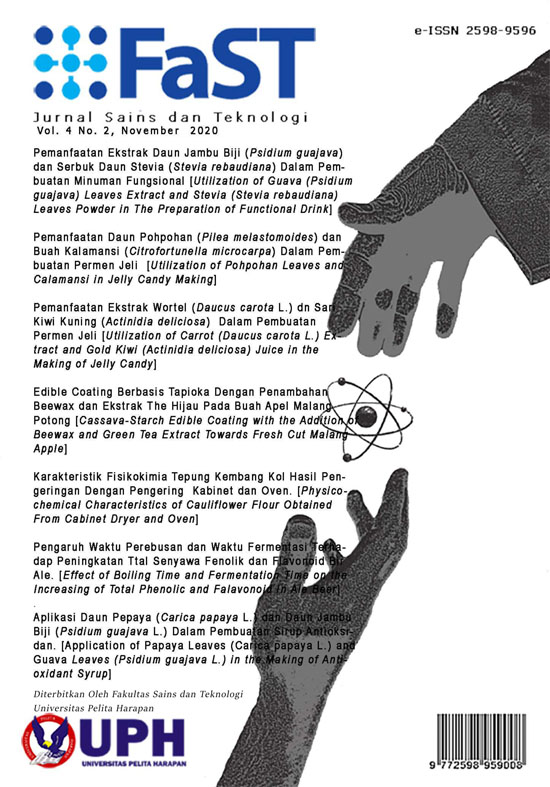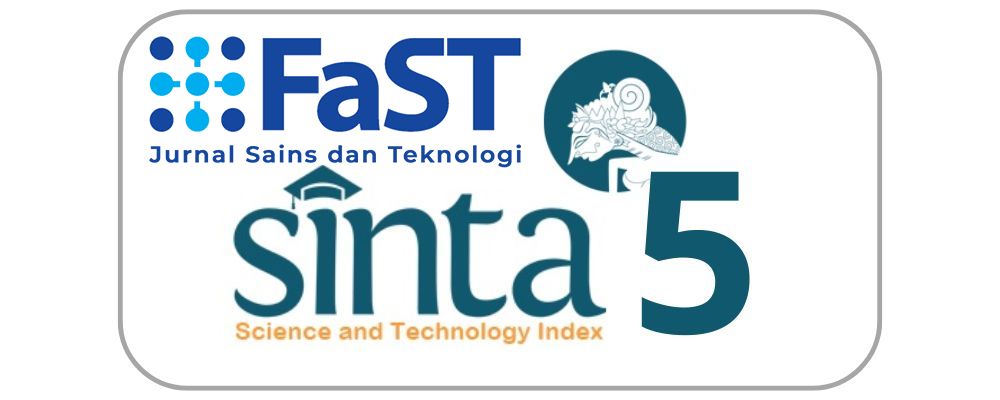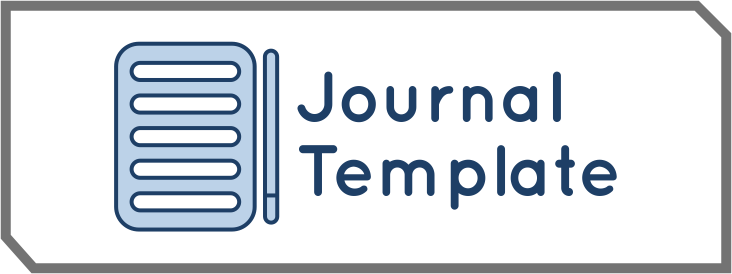PEMANFAATAN EKSTRAK WORTEL (Daucus carota L.) DAN SARI KIWI KUNING (Actinidia deliciosa) DALAM PEMBUATAN PERMEN JELI [Utilization of Carrot (Daucus carota L.) Extract and Gold Kiwi (Actinidia deliciosa) Juice in the Making of Jelly Candy]
Keywords:
antioxidant, β -carotene, carrot extract, gold kiwi fruit juice, jelly candyAbstract
Carrot is a vegetable with high β -carotene content as pigment as natural colorant, which both have many health benefits. Gold kiwifruit is a fruit with high vitamin C content. Therefore those micro nutrients and the pigment can be used in the development of food products. Jelly candy is liked by many but generally has low nutrition. This research aims to utilize carrot extract and gold kiwifruit juice in the making of attractive and nutritious candy jelly which is liked by many people. The method used is extraction of carrots and making juice from yellow kiwi and it is formulated to make jelly candy.The juice was obtained from gold kiwi fruits that were crushed with juicer and filtered. Carrots were extracted by maceration with three solvents (hexane, ethyl acetate, ethanol) and extraction time (24, 48, 72 hours) to obtain the best extract. The result is hexane and extraction time of 48 hours gave the best extract with IC50 value of 2036.25 ± 67,73 mg/l and β-carotene content of 11.422 ± 0,568 mg/100 g. The yellow kiwi juice and selected carrot extract were made formulations with addition carrot extract variables 0.2%, 0.4%, 0.6%, 0.8% and 1% mixed with yellow kiwi juice and heated to 78-800C and molded as jelly candy. The conclusion is the selected jelly candy is made with the addition of carrot extract 0.8%, has an IC50 of 23042.13 ± 832.87 mg / l, β -carotene 8.678 ± 0.068 mg / 100 g, yellowish red color, and is a candy the panelists liked the most. Apart from having an attractive color appearance, this jelly candy have healthy benefit which is contains high beta carotene as an antioxidants.
Abstrak
Wortel adalah sayuran yang banyak mengandung beta-karoten yaitu pigmen warna yang dapat dimanfaatkan sebagai pewarna alami dan memiliki banyak manfaat kesehatan. Kiwi kuning adalah buah dengan kandungan vitamin C yang tinggi. Kandungan mikro nutrisi dan pigmen warna tersebut dapat dimanfaatkan dalam pembuatan produk pangan. Permen jeli disukai banyak orang namun umumnya memiliki nutrisi yang kurang baik. Penelitian ini bertujuan untuk memanfaatkan ekstrak wortel dan sari kiwi kuning dalam pembuatan permen jeli yang bernutrisi, penampilan menarik dan disukai banyak orang. Sari kiwi kuning diperoleh dari kiwi kuning yang dihancurkan dengan juicer dan disaring. Wortel diekstrak dengan metode maserasi menggunakan tiga pelarut (heksana, etil asetat, etanol) dan waktu ekstraksi (24, 48, 72 jam) untuk mendapatkan ekstrak terbaik. Pelarut heksana dan waktu maserasi 48 jam memberikan hasil ekstrak terbaik dengan nilai IC50 2.036,25 ± 67,73 mg/l dan kadar beta-karoten 11,422 ± 0,568 mg/100 g. Sari kiwi kuning dan ekstrak wortel terbaik diformulasi menjadi permen jeli. Permen jeli terpilih adalah permen jeli yang terbuat dari sari kiwi kuning dengan penambahan ekstrak wortel sebanyak 0,8% dengan nilai IC50 sebesar 23.042,13 ± 832,87 mg/l, kadar beta-karoten sebesar 8,678 ± 0,068 mg/100 g, warna merah kekuningan, dan merupakan permen yang paling disukai panelis.
References
Ahamad, M. N., Saleemullah, M., Shah, H. U., Khalil, I. A., dan Salqoji, A.U.R. 2007. Determination of Beta Carotene Content in Fresh Vegetables Using High Performance Liquid Chromatography. Sarhad J. Agric. 23 (3): 767-770. Badan Standarisasi Nasional. 2008. SNI 3547.2:2008. Syarat Mutu Kembang Gula. Jakarta: Badan Standarisasi Nasional. Belitz, H. D., Grosch, W., Schieberle, P. 2009. “Food Chemistry” 4th ed. Springer-Verlag Berlin Heidelberg, Germany. Biswas, A. K., Sahoo, J., dan Chatli, M. K. 2011. A simple UV-Vis spectrophotometric method for determination of β-carotene content in raw carrot, sweet potato and supplemented chicken meat nuggets. LWT - Food Science and Technology 44 (8): 1809-1813. Boland, M., dan Moughan, P.J. 2013. Advances in Food and Nutrition Research Volume 68 : Nutritional Benefits of Kiwifruit. Academic Press, USA. Capillas, C. R dan Nollet, L. M. L. 2016. “Flow Injection Analysis of Food Additives”. CRC Press, Boca Raton. Caryabudi, N.L. 2010. Pemanfaatan Pewarna Alami dari Daun Cincau, Stroberi, dan Wortel pada Produk Pangan Fungsional Permen Jeli. Skripsi. Universitas Pelita Harapan, Karawaci. Charoen, R., Savedboworn, W., Phuditcharnchnakun, S. dan Khuntaweetap, T. 2015. Development of Antioxidant Gummy Jelly Candy Supplemented with Psidium guajava Leaf Extract. KMUTNB: IJAST. 8(2): 145-151. Darmon, N., Darmon, M., Maillot, M., dan Drenowski, A. 2005. A Nutrient Density Standard for Vegetables and Fruits: Nutrients per Calorie and Nutrients per Unit Cost. Journal of the American Dietetic Association, 105 (12): 1881-1887. Ghazi, A. 1999. Extraction of beta-carotene from orange peels. Nahrung 43 (4): 274-277. Hecker, S. 2014. Extraction of β-carotene from orange peel and carrot waste for cotton dyeing. Master Thesis. University of Boras, Sweden. Hunter, D.C., Skinner, M.A.,Wolber, F.M., Booth, C.L., Loh, J.M., Wohlers, M., Stevenson, L.M., dan Kruger, M.C. 2012. Consumption of Gold Kiwifruit Reduces Severity and Duration of Selected Upper Respiratory Tract Infection Symptoms and Increases Plasma Vitamin C Concentration in Healthy Older Adults. British Journal of Nutrition 108 (7): 1235-1245. Hutchings,J.B. 1999. “Food Color and Appearance” 2nd ed. Springer-Verlag US, USA. Imeson, A. 2010. “Food Stabilisers, Thickeners, and Gelling Agents”. Blackwell Publishing Ltd, UK. Incedayi, B., Tamer, C. E., Sinir, G. O., Suna, S., dan Copur, O. U. 2016. Impact of different drying parameters on color, β-carotene, antioxidant activity and minerals of apricot (Prunus armeniacaL.). Food Sci. Technol, Campinas 36 (1): 171-178. Inggrid, H.M., dan Santoso, H. 2014. Ekstraksi Antioksidan dan Senyawa Aktif dari Buah Kiwi (Actinidia deliciosa). Research Report - Engineering Science Vol. 2. Universitas Katolik Parahyangan, Bandung. Ishida, B. K., dan Chapman, M. H. 2009. Carotenoid extraction from plants using a novel, environmentally friendly solvent. J Agric Food Chem. 57 (3): 1051-1059. Kemit, N., Widarta, I.W.R., dan Nocianitri, K.A. Pengaruh Jenis Pelarut dan Waktu Maserasi terhadap Kandungan Senyawa Flavonoid dan Aktivitas Antioksidan Ekstrak Daun Alpukat (Persea Americana Mill). Jurnal ITEPA 5 (2): 130-141. Muchtadi, T.R. 2008. Teknologi Proses Pengolahan Pangan. Institut Pertanian Bogor, Bogor. Nagata, M. dan Yamashita, I. 1992. Simple method for simultaneous determination of chlorophyll and carotenoids in tomato fruit. J. Japan. Soc. Food Sci. Technol. (Nippon Shokuhin Kogyo Gakkaishi) 39 (10): 925-928. Naibaho, D.R.A, Nainggolan, R.J., dan Julianti, E. 2016. Pengaruh Perbandingan Sari Bit dengan Sari Buah Nenas dan Konsentrasi Gelatin terhadap Karakteristik Permen Jeli. J.Rekayasa Pangan dan Pert. 4 (2): 167-176. Namitha, K.K., dan Negi, P.S. 2010. Chemistry and Biotechnology of Carotenoids. Crit Rev Food Sci Nutr 50 (8): 728-760. Nielsen, S. S. 2010. “Food Analysis” 4th ed. Springrer Science+Business Media, New York. Octaviani, I. 2010. Pengaruh suhu dan waktu penyimpanan terhadap kadar antosianin dan warna pada permen jelly rosela (Hibiscus sabdariffa L.). Skripsi Doctoral dissertation. Widya Mandala Catholic University, Surabaya. Pal, R. S., Kumar, V. A., Arora, S., Sharma, A. K., Kumar, V., dan Agrawal, S. 2015. Physicochemical and antioxidant properties of kiwifruit as a function of cultivar and fruit harvested month. Braz. arch. biol. technol. 58 (2): 262-271. Pathare, P. B., Opara, U. L., dan Al-Said, F. A.-J. 2013. Colour Measurement and Analysis in Fresh and Processed Foods: A Review. Food Bioprocess Technol. 6: 36-60. Rahmawati, P.S., dan Adi, A.C. 2016. Daya Terima dan Zat Gizi Permen Jeli dengan Penambahan Bubuk Daun Kelor (Moringa oleifera). Media Gizi Indonesia 11 (1): 86-93. Rismandari, M., Agustini, T. W., dan Amalia, U. 2017. Karakteristik Permen Jelly dengan Penambahan Iota Karagenan dari Rumput Laut Eucheuma spinosum. Saintek Perikanan 12 (2): 103-108. Sa’adah, H., dan Nurhasnawati, H. 2015. Perbandingan Pelarut Etanol dan Air Pada Pembuatan Ekstrak Umbi Bawang Tiwai (Eleutherine americana Merr) Menggunakan Metode Maserasi. Jurnal Ilmiah Manutung 1 (2): 149-153. Sharmin, T., Ahmed, N., Abul, H., Hosain, M. M., Mondal, S. C., Haquel, M. R., Almas, M., dan Siddik, M. A. B. 2016. Extraction of Bioactive Compound from Some Fruits and Vegetables (Pomegranate Peel, Carrot and Tomato). American Journal of Food and Nutrition 4 (1): 8-19. Simanjuntak, M.S.N.B., Lubis, L.M., dan Ginting, S. 2016. Pengaruh Perbandingan Sari Buah Jambu Biji merah dengan Sari Buah Sirsak dan Konsentrasi Gum Arab terhadap Mutu Permen Jelly. J.Rekayasa Pangan dan Pert. 4 (1): 33-39. Sirait, A. Y., Pelealu, N. C., dan Yamlean, P. V. Y. 2016. Uji Daya Antibakteri Ekstrak Etanol Umbi Wortel (Daucus carota L.) terhadap Staphylococcus aureus dan Escherichia coli Secara In Vitro. PHARMACON Jurnal Ilmiah Farmasi - UNSRAT 5 (4): 145-154. Skinner, M., dan Hunter, D. 2013. “Bioactives in Fruit: Health Benefits and Functional Food”. John Wiley & Sons, Ltd, UK. Strati, I. F., dan Oreopoulou, V. 2016. Recovery and Isomerization of Carotenoids from Tomato Processing By-products. Waste and Biomass Valorization 7 (4): 843-850. Testolin, R., Huang, H., dan Ferguson, R. 2016. The Kiwifruit Genome. Springer International Publishing, Switzerland. USDA. 2016. Kiwifruit, ZESPRI, SunGold, Raw. USA: USDA National Nutrient Database for Standard Reference. Wahyuni, D. T., dan Widjanarko, S. B. 2015. Pengaruh Jenis Pelarut dan Lama Ekstraksi terhadap Ekstrak Karotenoid Labu Kuning dengan Metode Gelombang Ultrasonik. Jurnal Pangan dan Agroindustri 3 (2): 390-401. Yang, Y., Zhang, J., dan Shao, B. 2014. Quantitative Analysis of Fourteen Synthetic Dyes in Jelly and Gummy Candy by Ultra Performance Liquid Chromatography. Analytical Methods 6 (15): 5872 - 5878. Yara-Varón, E., Fabiano-Tixier, A. S., Balcells, M., Canela-Garayoa, R., Billy, A., dan Chemat, F. 2016. Is it possible to substitute hexane with green solvents for extraction of carotenoids? A theoretical versus experimental solubility study. RSC Adv. 6 (33): 27750-27759.
Downloads
Published
Issue
Section
License
“Authors who publish with this journal agree to the following terms:
1) Authors retain copyright and grant the journal right of first publication with the work simultaneously licensed under a Creative Commons Attribution License (CC-BY-SA 4.0) that allows others to share the work with an acknowledgement of the work's authorship and initial publication in this journal.
2) Authors are able to enter into separate, additional contractual arrangements for the non-exclusive distribution of the journal's published version of the work (e.g., post it to an institutional repository or publish it in a book), with an acknowledgement of its initial publication in this journal.
3) Authors are permitted and encouraged to post their work online (e.g., in institutional repositories or on their website). The final published PDF should be used and bibliographic details that credit the publication in this journal should be included.”





